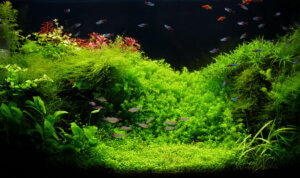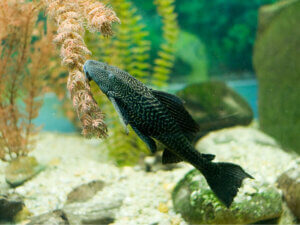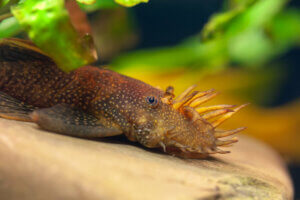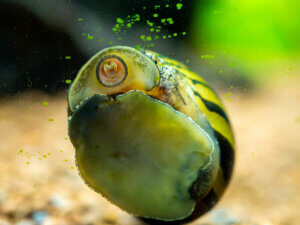Natural Aquarium Cleaners


Written and verified by the biologist Samuel Sanchez
The presence of algae in the fish tank is a phenomenon feared by any fish keeper. The pristine and unpolluted appearance of a planted aquarium can be threatened by a series of green or brown spots, which occupy various surfaces. So, what about talking about some natural aquarium cleaners to resolve this situation?
From crystals to stones, and branches to decorations, no element in contact with water is immune to algae growth. Of course, this is a purely aesthetic problem, as fish don’t care about the presence of algae in their environment.
However, besides the market products for the eradication of this “plague”, there are various natural cleaners that devour these annoying algae without altering the natural parameters of the aquarium. If you want to find out more, read on.
Why do algae appear in the aquarium?
Before listing these natural cleaners, it’s essential to know why algae appear in the first place, given that prevention is always the best treatment. Various websites specializing in fishkeeping list the following reasons:
- Overfeeding of fish. An excess of nutrients in the aquatic environment can cause an explosion of algae, a phenomenon ecologically known as eutrophication.
- Infrequent water change. Again, stagnant organic matter won’t be a source of food for fish, but it will be for decomposing bacteria, and later for algae. A weekly cleaning of the substrate of the aquarium can prevent such contamination.
- Excess fish. Too many fish in the tank means too many stools. Unfortunately, various pathogenic microorganisms and algae use this decaying matter as an energy source.
- Direct sunlight or inadequate artificial light cycle. Algae are photosynthetic plants, so they can take advantage of an excessive amount of light to proliferate excessively.
It should be noted that newly built aquariums tend to have a greater tendency to develop algae, because the ecological balance is only established 2-3 weeks after the introduction of all the elements. Now that we’ve reviewed the possible causes of algae, let’s see what natural cleaners can help you eradicate them.

Best natural aquarium cleaners: cleaner fish
Cleaner fish are always the best option to keep algae at bay. They can’t become a potential pest —as is the case with snails. However, they’re a good solution only for cleaning large aquariums, i.e. above 50 liters (2 ft3). Let’s look at two examples.
The suckermouth catfish
The suckermouth catfish (Hypostomus plecostomus) is a tropical fish well-known in the world of fishkeeping, because they feed efficiently on algae and organic waste. The greatest problem of this species is its size given that an adult can easily reach 30 centimeters (12 in).
Therefore, it’s better not to use them in aquariums of less than 250 liters (9 ft3). The situation becomes a little more complicated if we take into account their territoriality. Hence, it’s terribly unwise to place more than one fish per aquarium.
These fish are very tough, as they can withstand temperatures between 22°C to 29°C (72°F to 84°F) and a wide pH range.

The Ancistrus
Ancistrus is a genus of freshwater fish related to the suckermouth catfish. They both belong to the order of the Siluriformes. The essential difference between these species is the size, as Ancistrus usually don’t exceed 15 centimeters (6 in) in captivity.
For this reason, they’re suitable cleaners for smaller aquariums, with a volume of about 80 liters (3 ft3) or perhaps a little less. Moreover, they aren’t deemed as tough because they require more fixed temperatures —25°C or 26°C (77°F to 79°F), and more specific water parameters.

Invertebrates: smaller natural aquarium cleaners
Of course, the only natural cleaners suitable for small aquariums are shrimp and snails. Shrimp are always a better choice as they can’t become a pest. Unfortunately, they’re quite delicate and can become prey for some aquarium fish.
Here’s a list of freshwater snails that can keep the algae in your aquarium at bay:
- Neritina natalensis or zebra snail: an excellent algae eater, very easy to maintain.
- Clithon corona: similar to the previous one, but smaller in size and with thorns on the shell.
- Anatome helena: an assassin snail that preys on herbivorous snails.
There are many more examples of cleaning invertebrates. With a single internet search, you can find multiple guides that list the most common species. All of them are good options because they’re cheap and tough.

Natural aquarium cleaners: an efficient remedy
As we’ve seen, there are several options available when dealing with an algae infestation in the aquarium. However, the fish we’ve shown you yield better results in a tank of sufficient volume. In any case, they can’t become a plague.
In addition to being beautiful and interesting components of the aquarium, these animals perform essential cleaning work without disturbing the natural rhythm of the ecosystem in the aquarium.
The presence of algae in the fish tank is a phenomenon feared by any fish keeper. The pristine and unpolluted appearance of a planted aquarium can be threatened by a series of green or brown spots, which occupy various surfaces. So, what about talking about some natural aquarium cleaners to resolve this situation?
From crystals to stones, and branches to decorations, no element in contact with water is immune to algae growth. Of course, this is a purely aesthetic problem, as fish don’t care about the presence of algae in their environment.
However, besides the market products for the eradication of this “plague”, there are various natural cleaners that devour these annoying algae without altering the natural parameters of the aquarium. If you want to find out more, read on.
Why do algae appear in the aquarium?
Before listing these natural cleaners, it’s essential to know why algae appear in the first place, given that prevention is always the best treatment. Various websites specializing in fishkeeping list the following reasons:
- Overfeeding of fish. An excess of nutrients in the aquatic environment can cause an explosion of algae, a phenomenon ecologically known as eutrophication.
- Infrequent water change. Again, stagnant organic matter won’t be a source of food for fish, but it will be for decomposing bacteria, and later for algae. A weekly cleaning of the substrate of the aquarium can prevent such contamination.
- Excess fish. Too many fish in the tank means too many stools. Unfortunately, various pathogenic microorganisms and algae use this decaying matter as an energy source.
- Direct sunlight or inadequate artificial light cycle. Algae are photosynthetic plants, so they can take advantage of an excessive amount of light to proliferate excessively.
It should be noted that newly built aquariums tend to have a greater tendency to develop algae, because the ecological balance is only established 2-3 weeks after the introduction of all the elements. Now that we’ve reviewed the possible causes of algae, let’s see what natural cleaners can help you eradicate them.

Best natural aquarium cleaners: cleaner fish
Cleaner fish are always the best option to keep algae at bay. They can’t become a potential pest —as is the case with snails. However, they’re a good solution only for cleaning large aquariums, i.e. above 50 liters (2 ft3). Let’s look at two examples.
The suckermouth catfish
The suckermouth catfish (Hypostomus plecostomus) is a tropical fish well-known in the world of fishkeeping, because they feed efficiently on algae and organic waste. The greatest problem of this species is its size given that an adult can easily reach 30 centimeters (12 in).
Therefore, it’s better not to use them in aquariums of less than 250 liters (9 ft3). The situation becomes a little more complicated if we take into account their territoriality. Hence, it’s terribly unwise to place more than one fish per aquarium.
These fish are very tough, as they can withstand temperatures between 22°C to 29°C (72°F to 84°F) and a wide pH range.

The Ancistrus
Ancistrus is a genus of freshwater fish related to the suckermouth catfish. They both belong to the order of the Siluriformes. The essential difference between these species is the size, as Ancistrus usually don’t exceed 15 centimeters (6 in) in captivity.
For this reason, they’re suitable cleaners for smaller aquariums, with a volume of about 80 liters (3 ft3) or perhaps a little less. Moreover, they aren’t deemed as tough because they require more fixed temperatures —25°C or 26°C (77°F to 79°F), and more specific water parameters.

Invertebrates: smaller natural aquarium cleaners
Of course, the only natural cleaners suitable for small aquariums are shrimp and snails. Shrimp are always a better choice as they can’t become a pest. Unfortunately, they’re quite delicate and can become prey for some aquarium fish.
Here’s a list of freshwater snails that can keep the algae in your aquarium at bay:
- Neritina natalensis or zebra snail: an excellent algae eater, very easy to maintain.
- Clithon corona: similar to the previous one, but smaller in size and with thorns on the shell.
- Anatome helena: an assassin snail that preys on herbivorous snails.
There are many more examples of cleaning invertebrates. With a single internet search, you can find multiple guides that list the most common species. All of them are good options because they’re cheap and tough.

Natural aquarium cleaners: an efficient remedy
As we’ve seen, there are several options available when dealing with an algae infestation in the aquarium. However, the fish we’ve shown you yield better results in a tank of sufficient volume. In any case, they can’t become a plague.
In addition to being beautiful and interesting components of the aquarium, these animals perform essential cleaning work without disturbing the natural rhythm of the ecosystem in the aquarium.
All cited sources were thoroughly reviewed by our team to ensure their quality, reliability, currency, and validity. The bibliography of this article was considered reliable and of academic or scientific accuracy.
- Algas en el acuario, zooplus magazine. Recogido a 12 de octubre en https://www.zooplus.es/magazine/peces/cuidado-del-acuario-y-tratamiento-del-agua/algas-acuario
- Ancistrus, todosobreacuarios.com. Recogido a 12 de octubre en https://todosobreacuarios.com/ancistrus/
This text is provided for informational purposes only and does not replace consultation with a professional. If in doubt, consult your specialist.








